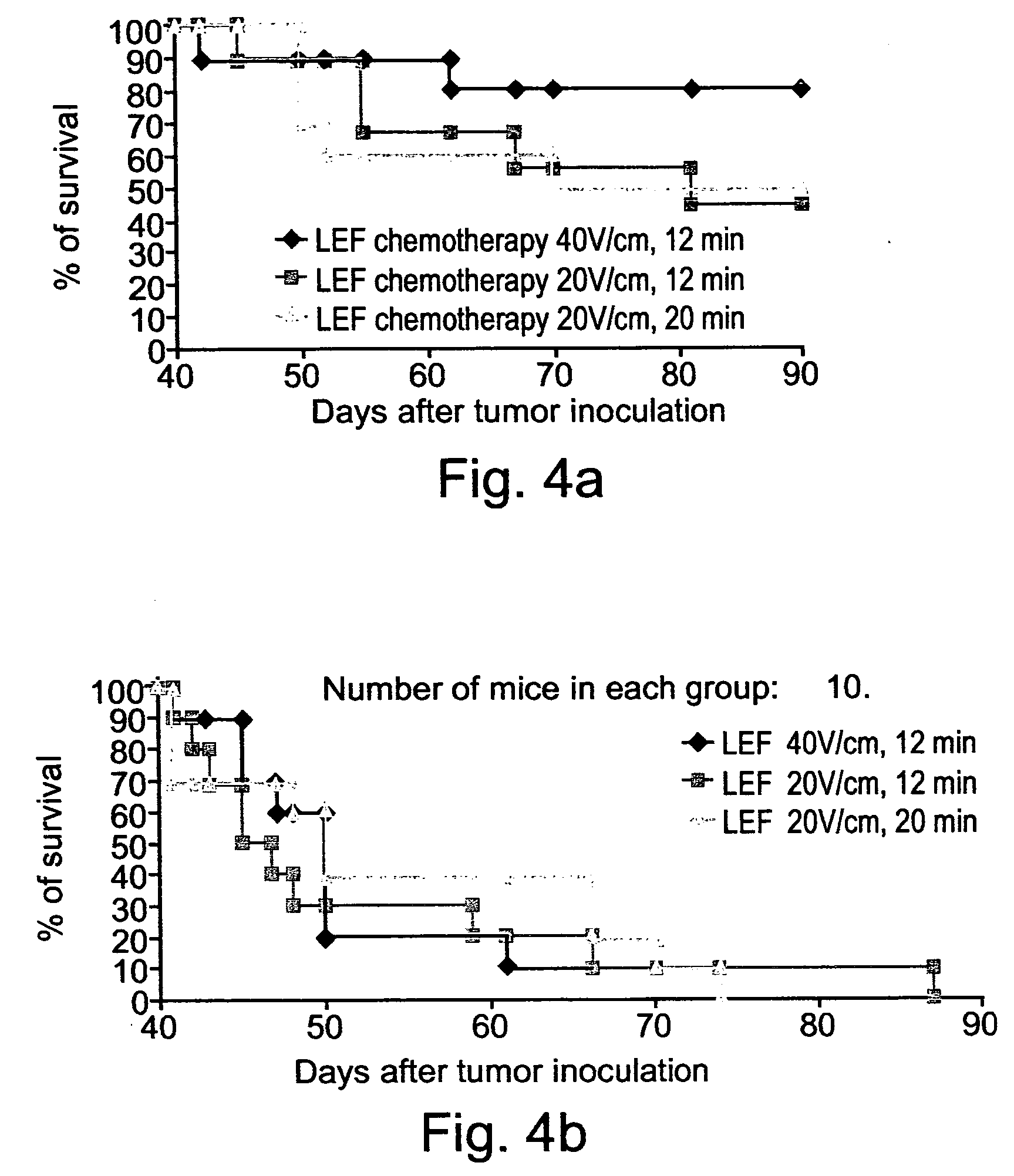Method and apparatus for treating tumors using low strength electric fields
a low-power electric field and tumor technology, applied in the field of low-power electric field treatment of tumors, can solve the problems of difficult diagnosis and treatment of colon cancer, 37% of colorectal cancer is diagnosed, and significant health problems of breast cancer, so as to facilitate tumor tissue treatment, and facilitate the effect of tumor tissue treatmen
- Summary
- Abstract
- Description
- Claims
- Application Information
AI Technical Summary
Benefits of technology
Problems solved by technology
Method used
Image
Examples
example 1
Life Expectancy Prolongation and Cure of Mice Bearing CT-26 Colon Carcinoma by Low-Strength Electric Field Enhanced Cancer Chemotherapy
[0135] Colorectal carcinoma is the second most frequent malignancy in Western world--it is estimated that there are nearly 400,000 deaths from CRC worldwide annually. Surgery can cure approximately 50% of patients and the overall five-year survival of patients with CRC is on the order of 50-55%. However, a considerable number of patients cannot undergo surgery, even at an early stage of the disease, due to severe complications. Therefore, effective treatment modalities for patients who cannot undergo surgery or have recurrent disease are highly desirable. Low electric field enhanced cancer chemotherapy (LEFCT-EC) represents a potentially valuable treatment option in such patients. Thus, in order to determine the potential of LEFCT-EC to enhance treatment of colon carcinoma, mice bearing tumors of a metastatic colon carcinoma cell line were treated wi...
example 2
Tumor Growth Retardation and Cure of B16 Melanoma Bearing Mice by Low-Strength Electric Field Enhanced Cancer Chemotherapy
[0164] Melanoma is a very aggressive type of skin cancer whose incidence is on the increase and which has a very high mortality rate. There do not exist any satisfactory treatment modalities for this dangerous disease. Since it has previously been demonstrated that treatment of cells with LEFs has the capacity to lead to efficient cellular uptake of macromolecules, the capacity of LEF treatment to enhance uptake of chemotherapeutic agents by melanoma cells, thereby potentiating their anti melanoma activity, was demonstrated as follows.
[0165] Materials and Methods:
[0166] Animals: C57BL / 6 male mice were obtained from the breeding colony of Tel-Aviv University, Israel. Mice were used at 8-12 weeks of age. Animal care and experimentation was carried out in accordance with Tel-Aviv University guidelines.
[0167] Melanoma tumor cell line: The highly metastatic, poorly im...
example 3
Tumor Growth Retardation, Cure and Induction of Anti Tumor Immunity in Breast Carcinoma Bearing Mice Following Low-Strength Electric Field Enhanced Cancer Chemotherapy
[0191] Breast cancer, a frequently lethal and highly debilitating disease, is the most common cancer in the Western world, affecting about one woman in nine. To date, however, no satisfactory treatments are available for this widespread disease. Since it has previously been demonstrated that treatment of cells with LEFs has the capacity to lead to efficient cellular uptake of macromolecules, the capacity of LEF treatment to enhance uptake of chemotherapeutic agents by mammary carcinoma cells, thereby potentiating their cytotoxic activity against such cells, was demonstrated as follows.
[0192] Materials and Methods:
[0193] Animals: BALB / c female mice between the ages of 8 to 12 weeks obtained from the breeding colony of Tel-Aviv University, Israel were used in vivo tumor therapy experiments. Animal care and experimentatio...
PUM
| Property | Measurement | Unit |
|---|---|---|
| repetition frequency | aaaaa | aaaaa |
| electrical potential | aaaaa | aaaaa |
| permeability | aaaaa | aaaaa |
Abstract
Description
Claims
Application Information
 Login to View More
Login to View More - R&D
- Intellectual Property
- Life Sciences
- Materials
- Tech Scout
- Unparalleled Data Quality
- Higher Quality Content
- 60% Fewer Hallucinations
Browse by: Latest US Patents, China's latest patents, Technical Efficacy Thesaurus, Application Domain, Technology Topic, Popular Technical Reports.
© 2025 PatSnap. All rights reserved.Legal|Privacy policy|Modern Slavery Act Transparency Statement|Sitemap|About US| Contact US: help@patsnap.com



